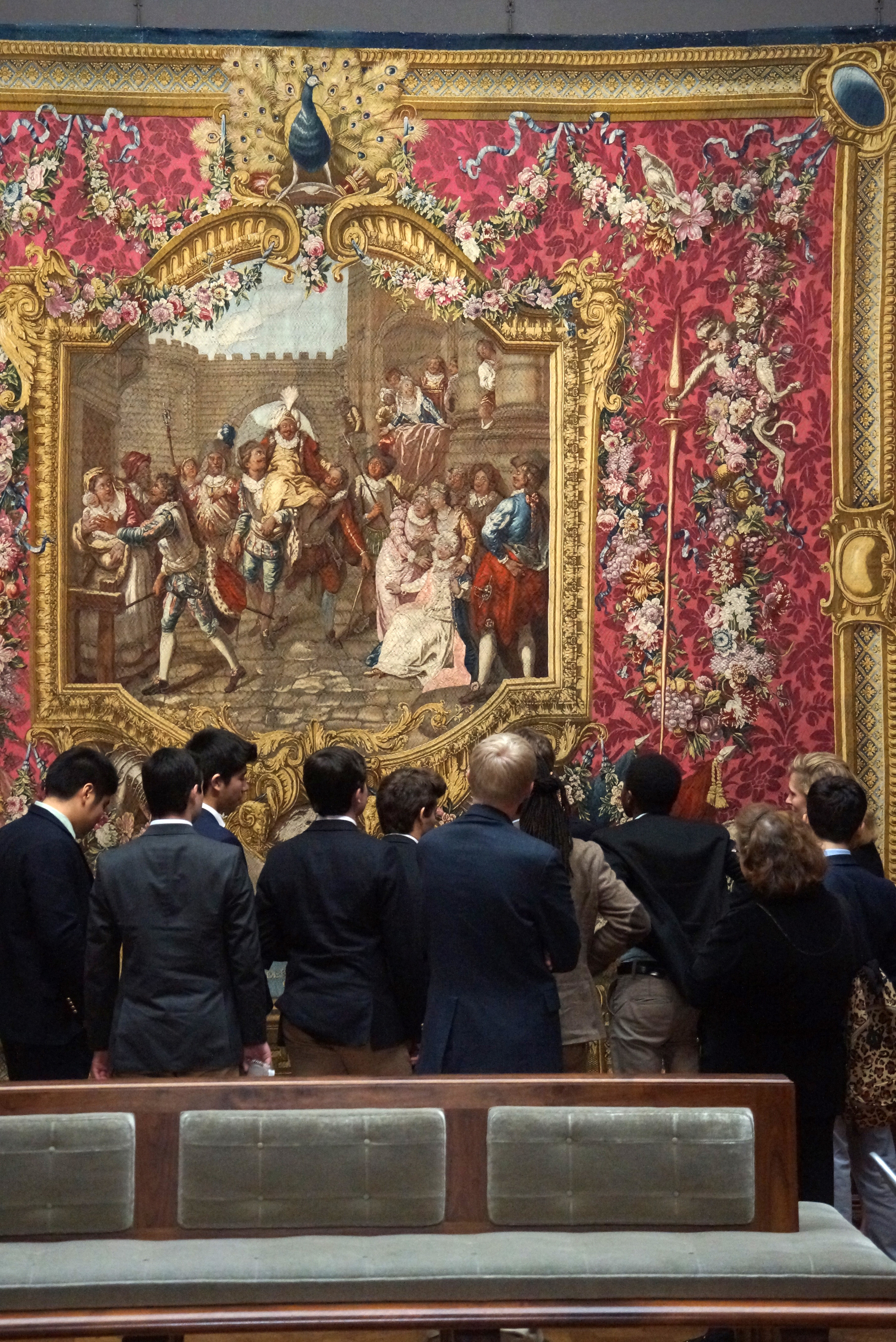Modern Language Students Explore Coypel’s “Don Quixote” Tapestries at the Frick
On April 1, French teacher Megan Ryan, Spanish teacher Giurissa Félix-Grace and art teacher Nik Vlahos accompanied boys in French IV and Spanish II/IV classes to The Frick Collection to view the exhibition, “Coypel’s Don Quixote Tapestries: Illustrating a Spanish Novel in Eighteenth-Century France,” which commemorates the 400th anniversary of the publication of the second volume of “Don Quixote.” The Frick Collection was assembled by industrialist Henry Clay Frick and is housed in his family’s former residence on Fifth Avenue. After their tour, the boys posed for a group photo, taken by Jeremy Katz ’04, in The Garden Court designed by John Russell Pope, who designed the original building of the National Gallery of Art in Washington, D.C. Melanie McMahon offers the following report:
The Frick’s website explains that Cervantes’s “Don Quixote” (fully titled “The Ingenious Gentleman Don Quixote of La Mancha”) was wildly popular when published in two volumes in 1605 and 1615. The Frick’s knowledgeable tour guides explained that the adventures of the knight Don Quixote and his companion Sancho Panza inspired a myriad of paintings, prints, interiors, operas and ballets, as well as Charles-Antoine Coypel’s exquisite tapestries, three of which are currently on display at the Frick. The tapestries, originally accessible only to the wealthy, were hung in Louis XV’s rooms and also given as diplomatic gifts. On loan from the J. Paul Getty Museum in Los Angeles, they were created 100 years after Cervantes’s work was published and were “translated” from a series of 28 commissioned “cartoons” or designs produced by Coypel, painter to Louis XV, over the course of 20 years. Four of Coypel’s original paintings, never before seen in New York, are on display; they are on loan from the Palais Impérial de Compiègne and the Musée Jacquemart-André, Paris. Also included in the exhibition are several of the 25 black-and-white engravings made for the masses by Coypel.
Ms. Grace explained, “I had not originally included Miguel de Cervantes in this year’s Upper School Spanish curriculum, but modified it once I learned of The Frick Collection’s new exhibit. I could not squander the opportunity to give the students a rare visual view into the literary world of Spanish author, poet and soldier Miguel de Cervantes Saavedra. His novel, “El ingenioso hidalgo don Quijote de la Mancha,” is credited as the first modern novel. Cervantes does not aim for a ‘single vision.’ His novel serves as a demystification of the popular literary genres of the time and is a spectacular recreation of the world during Cervantes’s time. At the end of our visit, the tour guides were impressed by our French and Spanish students’ interest. In their words, ‘They enlivened the museum by offering insightful commentary on the Don Quixote tapestries, and we hope to welcome them back for further adventures in art history.’ The Spanish students will receive extra credit for writing about their visit to the Frick, and for the next few weeks, will be reading a graphic novel based on Cervantes’s book.”
Ms. Ryan added, “Ms. Grace came to me earlier in the semester and asked if the boys in French IV would like to join her and her students for this very special visit; I of course said yes! As I told my students, one could very easily walk by these tapestries and respond with a remark such as, ‘Look at those beautifully made rugs hanging on the wall’ and miss all of the components that are woven into their background. There is obviously the story of Don Quixote (Don Quichotte, en français!) and the significance of that literary work. There is also, however, the story of the French painter Charles-Antoine Coypel whose works inspired these tapestries; the important economic and even political roles of the Manufacture des Gobelins (the Parisian workshop where three of the works displayed were produced) in 17th and 18th century France; and, lastly, the UNESCO recognized art of French tapestry making. French IV students examined all of these ‘threads’ prior to our visit to the Frick, which made our tour all the richer.”
Along with describing Coypel’s work, the tour guides engaged the boys in conversation, breaking them into groups so they might explore various elements of the tapestries, from the comedic, theatrical figures of Don Quixote and Sancho Panza, to the bystanders and animals, including the monkeys who symbolized the playful nature of Cervantes’s epic work, the peacocks who symbolized Quixote’s pride, and the dogs who represented the loyalty of Sancho Panza to the main character. The Browning visitors learned that the blood from hundreds of Mexican beetles was used to create the gorgeous “hot pink” color used in the border or “trompe-l’oeil” frame created to enhance the central image.
As part of their tour, the boys also viewed and discussed two Flemish tapestries (part of the Frick’s permanent collection) translated from Cervantes’ work, comparing their subdued colors and delicate figures with the bright colors and flamboyant figures of Coypel’s tapestries. They also had the opportunity to view other works in the Frick Collection by Renoir, Rembrandt, Goya, Vermeer, Whistler, Gainsborough and Turner, among others.







